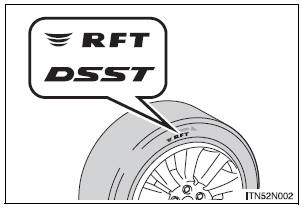Toyota Sienna 2010-2025 Owners Manual: If you have a flat tire (vehicles with run-flat tires)
Your vehicle is not equipped with a spare tire, but instead you can continue driving the vehicle with run-flat tires even if any tire goes flat.
In this case, slow down and drive with extra caution.
Run-flat tires (A “RFT” or “DSST” mark is molded on the sidewall)
Take your vehicle to the nearest Toyota dealer or authorized tire dealer as soon as possible if any tire goes flat.
The vehicle can be driven for a maximum of 100 miles (160 km) at a speed below 50 mph (80 km/h) after the tire pressure warning light comes on.

In some condition (such as at high temperatures)
You cannot continue driving for up to 100 miles (160 km).
For the detailed information on run-flat tires
See the tire warranty booklet.
| NOTICE When replacing the tires When removing or fitting the wheels, tires or the tire pressure warning valve and transmitter, contact your Toyota dealer as the tire pressure warning valve and transmitter may be damaged if not handled correctly. When driving over bumps If a vehicle has a flat tire, the vehicle height will be lower than usual. Ensure that nothing strikes the bottom of the vehicle. To avoid damaging the tire pressure warning valves and transmitters When a tire is repaired with liquid sealants, the tire pressure warning valve and transmitter may not operate properly. If a liquid sealant is used, contact your Toyota dealer or other qualified service shop as soon as possible. Make sure to replace the tire pressure warning valve and transmitter when replacing the tire. |
 If a warning message is displayed
If a warning message is displayed
If a warning message is shown on the multi-information display,
stay calm and perform the following actions:
Master warning light
The master warning light also comes on or flashes in order ...
 If you have a flat tire
(vehicles with a compact
spare tire)
If you have a flat tire
(vehicles with a compact
spare tire)
Your vehicle is equipped with a spare tire. The flat tire can be
replaced with the spare tire.
For details about tires:
WARNINGIf you have a flat tire
Do not continue driving with a fla ...
Other materials:
Rear Occupant Classification Sensor RH Circuit
Malfunction
DTC B1783 Rear Occupant Classification Sensor RH Circuit
Malfunction
DESCRIPTION
The rear occupant classification sensor RH circuit consists of the occupant
classification ECU and the
rear occupant classification sensor RH.
DTC B1783 is recorded when a malfunction is detected in the rear oc ...
System check
HINT:
Performing a SYSTEM CHECK enables the system,
which consists of the multiple actuators, to be operated
without removing any parts. In addition, it can show
whether or not any DTCs are set, and can detect
potential malfunctions in the system. The SYSTEM
CHECK can be performed with an inte ...
Open in Stop Light Switch Circuit
DTC C1249/49 Open in Stop Light Switch Circuit
DESCRIPTION
WIRING DIAGRAM
INSPECTION PROCEDURE
1 CHECK STOP LIGHT SWITCH OPERATION
(a) Check that the stop light comes on when the brake pedal
is depressed and goes off when the brake pedal is
released.
OK
HINT:
Check the stop li ...
